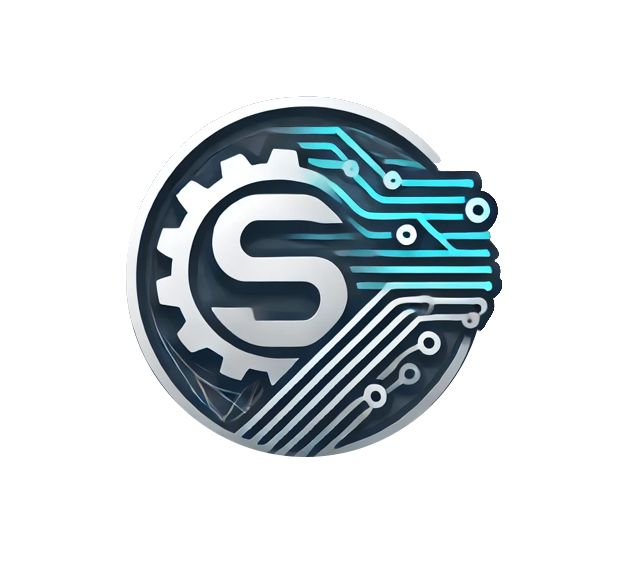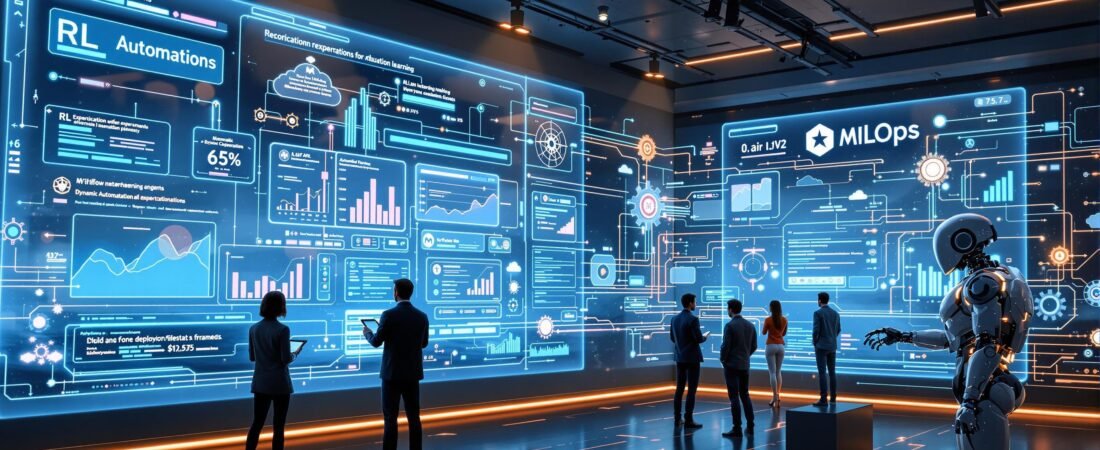What is Reinforcement Learning and Why Does It Need MLOps?
Reinforcement learning (RL) is a branch of machine learning where agents learn to make decisions by interacting with an environment. Unlike supervised learning, where models learn from labeled data, RL agents learn through trial and error, receiving feedback in the form of rewards or penalties. This approach has enabled breakthroughs in robotics, game playing, recommendation systems, and autonomous vehicles.
How Reinforcement Learning Works
In RL, an agent observes the state of the environment, takes an action, and receives a reward. The goal is to maximize the cumulative reward over time. The agent’s behavior is defined by a policy, which is updated based on experience. Popular RL algorithms include Q-learning, Deep Q-Networks (DQN), Policy Gradients, and Proximal Policy Optimization (PPO).
Why Reinforcement Learning Needs MLOps
While RL offers powerful capabilities, deploying RL solutions in production presents unique challenges. Here’s why MLOps (Machine Learning Operations) is essential for reinforcement learning:
Complex Experimentation: RL workflows involve running thousands of experiments with different hyperparameters, environments, and reward structures. MLOps tools help automate, track, and reproduce these experiments efficiently.
Environment Management: RL agents require simulated or real environments for training and testing. Managing these environments, ensuring consistency, and versioning them is critical—MLOps provides the necessary infrastructure.
Continuous Training and Deployment: RL agents often need to adapt to changing environments or business goals. MLOps enables continuous integration, retraining, and deployment of RL models, ensuring agents remain effective over time.
Monitoring and Evaluation: Unlike static models, RL agents can exhibit unpredictable behaviors. MLOps frameworks support robust monitoring, logging, and evaluation pipelines to detect issues like reward hacking, policy drift, or performance degradation.
Collaboration and Governance: RL projects typically involve data scientists, engineers, and domain experts. MLOps platforms facilitate collaboration, enforce governance, and ensure compliance with organizational standards.
The Business Value of MLOps for RL
Integrating MLOps into RL workflows accelerates experimentation, reduces operational risks, and shortens the time from research to production. Organizations can scale RL solutions more reliably, maintain high-quality deployments, and respond quickly to new challenges or opportunities.
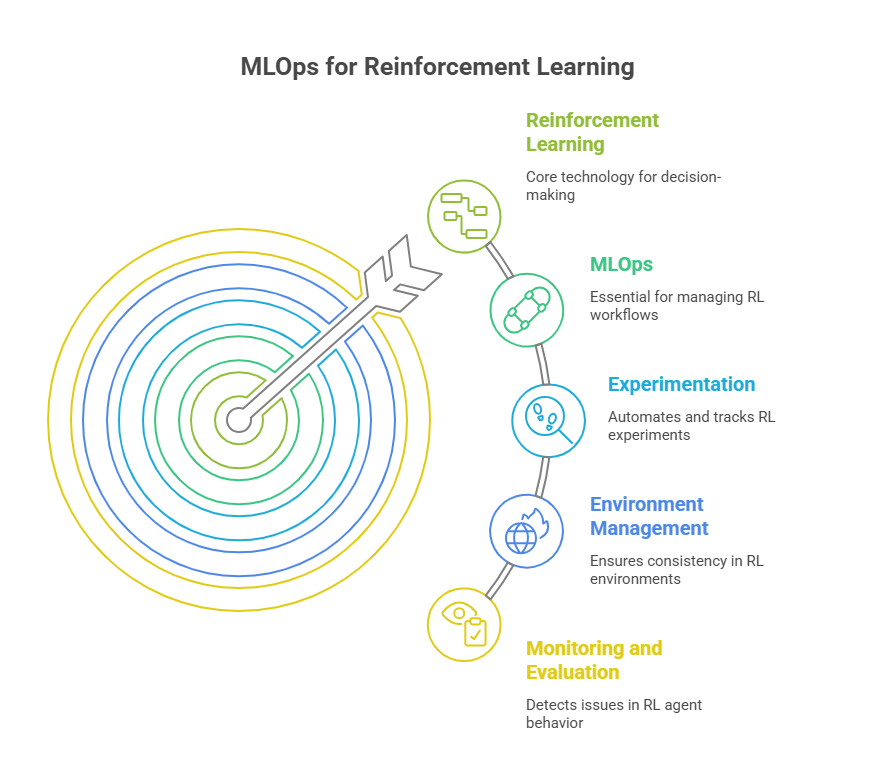
Unique Challenges of RL in Production Systems
Reinforcement learning (RL) is revolutionizing industries by enabling intelligent agents to make autonomous decisions. However, deploying RL solutions in real-world production systems introduces a set of unique challenges that differ significantly from traditional machine learning. Understanding these challenges is crucial for building robust, scalable, and reliable RL applications.
- High Variability and Unpredictability
RL agents learn by exploring and interacting with dynamic environments. This exploration can lead to unpredictable behaviors, especially in complex or partially observable settings. In production, such variability can result in inconsistent performance, unexpected actions, or even system failures if not properly managed.
- Environment Management and Reproducibility
Unlike supervised learning, RL requires access to environments—either simulated or real—for training and evaluation. Ensuring that these environments are consistent, versioned, and reproducible is a major challenge. Any change in the environment can impact agent performance, making it difficult to compare experiments or reproduce results.
- Long Training Times and Resource Intensity
Training RL agents often demands significant computational resources and time, especially for deep reinforcement learning. Large-scale simulations, distributed training, and hyperparameter sweeps can quickly escalate infrastructure costs. Efficient resource management and automation are essential to keep projects on track and within budget.
- Safety and Risk Management
In production, RL agents may interact with critical systems or real users. Unintended behaviors, reward hacking, or policy drift can lead to safety risks, financial losses, or reputational damage. Implementing robust monitoring, fail-safes, and human-in-the-loop mechanisms is vital to mitigate these risks.
- Continuous Learning and Adaptation
Production environments are rarely static. RL agents must adapt to changing conditions, user behaviors, or business objectives. This requires continuous retraining, validation, and deployment pipelines—core elements of MLOps for RL. Without automation, maintaining agent performance over time becomes unsustainable.
- Monitoring and Explainability
RL models are often seen as black boxes, making it difficult to interpret their decisions. In production, explainability is crucial for debugging, compliance, and building trust with stakeholders. Advanced monitoring, logging, and explainability tools are needed to track agent actions, rewards, and policy changes.
- Integration with Existing Systems
Deploying RL agents in production means integrating them with legacy systems, APIs, and data pipelines. Ensuring seamless communication, low latency, and robust error handling requires careful engineering and orchestration—areas where MLOps practices are indispensable.
Building Automated Experiment Pipelines for RL
Automating experiment pipelines is a cornerstone of successful reinforcement learning (RL) projects, especially when aiming for production-grade solutions. Automated pipelines streamline the process of training, evaluating, and deploying RL agents, enabling rapid iteration, reproducibility, and scalability. In this article, we explore how to design and implement automated experiment pipelines for RL, highlighting best practices and key tools.
Why Automation Matters in RL Experimentation
Reinforcement learning workflows are inherently complex. They involve running numerous experiments with different hyperparameters, environments, and reward structures. Manual management of these experiments is not only time-consuming but also prone to errors and inconsistencies. Automation ensures that every experiment is tracked, reproducible, and easy to compare, which is essential for both research and production environments.
Key Components of an Automated RL Experiment Pipeline
A robust RL experiment pipeline typically includes the following components:
Experiment Orchestration: Tools like Kubeflow Pipelines, MLflow, or Airflow can automate the scheduling and execution of RL experiments, from data preparation to model training and evaluation.
Hyperparameter Optimization: Automated hyperparameter tuning frameworks (e.g., Optuna, Ray Tune) help efficiently search for the best configurations, accelerating the discovery of optimal RL policies.
Environment Management: Versioning and managing environments (simulators or real-world interfaces) is crucial for reproducibility. Tools like OpenAI Gym or custom wrappers can help standardize environment interfaces.
Experiment Tracking and Logging: Comprehensive tracking of experiment metadata, configurations, and results is vital. MLflow, Weights & Biases, or TensorBoard are popular choices for logging and visualization.
Automated Evaluation and Validation: Pipelines should include automated evaluation steps to assess agent performance, detect regressions, and validate results before deployment.
Model Registry and Deployment: Integrating a model registry allows for versioning, storing, and deploying trained RL agents in a controlled and auditable manner.
Best Practices for Automating RL Pipelines
To maximize the benefits of automation in RL, consider the following best practices:
Modular Design: Break down the pipeline into reusable, independent modules (e.g., data ingestion, training, evaluation) to facilitate maintenance and scalability.
Parameterization: Use configuration files or parameter servers to manage experiment settings, making it easy to launch new experiments with different parameters.
Reproducibility: Ensure that every experiment is fully reproducible by tracking code versions, environment states, and random seeds.
Scalability: Leverage distributed computing and cloud resources to run multiple experiments in parallel, reducing time-to-result.
Monitoring and Alerts: Implement real-time monitoring and alerting to quickly identify failed runs, performance drops, or resource bottlenecks.
Example: Automating RL Experiments with MLflow and Ray Tune
A typical automated RL pipeline might use Ray Tune for distributed hyperparameter optimization and MLflow for experiment tracking. For example, you can define a training function for your RL agent, configure Ray Tune to explore different hyperparameters, and log results to MLflow for easy comparison and analysis.
Business Impact of Automated RL Pipelines
Automated experiment pipelines accelerate RL research, reduce operational overhead, and enable organizations to scale their RL initiatives efficiently. By minimizing manual intervention and ensuring consistent, reproducible results, businesses can bring RL solutions to production faster and with greater confidence.
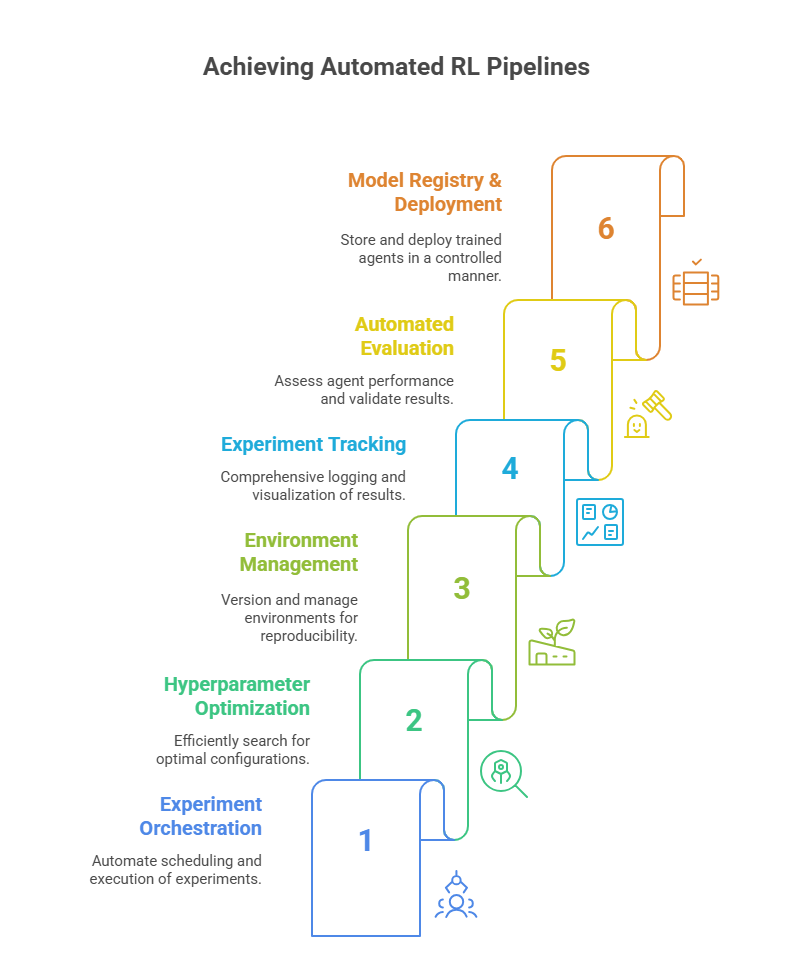
Tracking and Versioning RL Experiments and Results
Effective tracking and versioning of reinforcement learning (RL) experiments are critical for building reliable, reproducible, and scalable RL systems. As RL workflows involve running thousands of experiments with varying hyperparameters, environments, and code versions, robust experiment management becomes a foundation for both research and production success. In this article, we explore best practices and tools for tracking and versioning RL experiments and results.
Why Tracking and Versioning Matter in RL
Reinforcement learning is inherently iterative and experimental. Each run can produce different results due to stochasticity in environments, random seeds, or policy updates. Without systematic tracking and versioning, it becomes nearly impossible to:
Reproduce successful experiments
Compare different approaches and configurations
Debug failures or regressions
Collaborate efficiently within teams
Maintain compliance and auditability in production
Key Elements to Track in RL Experiments
To ensure comprehensive experiment management, it’s essential to track:
Code Version: The exact codebase (including dependencies) used for each experiment, often managed with Git or similar version control systems.
Hyperparameters: All parameters influencing agent training, such as learning rates, discount factors, and exploration strategies.
Environment Version: The specific version of the simulator or real-world environment, including any configuration files or seeds.
Experiment Metadata: Descriptive information like experiment name, author, date, and purpose.
Results and Metrics: Performance metrics (e.g., cumulative reward, episode length), logs, and artifacts generated during training and evaluation.
Model Artifacts: Trained agent weights, checkpoints, and policy files.
Tools for Tracking and Versioning RL Experiments
Modern MLOps tools make it easier to manage RL experiments at scale. Popular solutions include:
MLflow: Provides experiment tracking, model registry, and artifact storage. Integrates well with RL frameworks and supports logging custom metrics.
Weights & Biases (W&B): Offers real-time experiment tracking, visualization, and collaboration features tailored for deep learning and RL.
TensorBoard: Widely used for visualizing training metrics, especially in TensorFlow-based RL projects.
DVC (Data Version Control): Enables versioning of datasets, models, and experiment outputs alongside code.
Best Practices for RL Experiment Management
To maximize reproducibility and efficiency, follow these best practices:
Automate Logging: Integrate tracking tools directly into your RL training scripts to automatically log parameters, metrics, and artifacts.
Use Unique Identifiers: Assign unique IDs or tags to each experiment for easy reference and comparison.
Version Everything: Track not only code and models but also environment configurations and data snapshots.
Centralize Storage: Store experiment metadata, logs, and artifacts in a centralized, accessible location to facilitate collaboration and auditing.
Document Experiments: Maintain clear documentation for each experiment, including goals, changes, and observations.
Example: Tracking RL Experiments with MLflow
A typical RL workflow might use MLflow to log hyperparameters, metrics, and model artifacts for each training run. This allows teams to compare results across experiments, roll back to previous versions, and deploy the best-performing agents with confidence.
Business Value of Robust Experiment Tracking
Systematic tracking and versioning accelerate RL development, reduce operational risks, and ensure that successful experiments can be reliably reproduced and deployed. This is especially important in regulated industries or mission-critical applications, where traceability and auditability are essential.
Hyperparameter Tuning and Experiment Management in Reinforcement Learning
Hyperparameter tuning and experiment management are two of the most critical aspects of building high-performing reinforcement learning (RL) agents. As RL models are highly sensitive to hyperparameter choices and experiment configurations, systematic optimization and robust tracking are essential for both research and production environments. W tym artykule przedstawiamy najlepsze praktyki, narzędzia oraz strategie automatyzacji tuningu hiperparametrów i zarządzania eksperymentami w RL.
Why Hyperparameter Tuning Matters in RL
Reinforcement learning algorithms rely on a wide range of hyperparameters, such as learning rate, discount factor (gamma), exploration strategy, batch size, and network architecture. Even small changes in these values can lead to significant differences in agent performance. Manual tuning is not only time-consuming but also often leads to suboptimal results. Automated hyperparameter optimization helps:
Discover the best-performing configurations faster
Reduce human bias and error
Improve reproducibility and scalability of RL workflows
Key Strategies for Hyperparameter Tuning in RL
There are several proven strategies for hyperparameter tuning in RL:
Grid Search: Systematically explores all combinations of predefined hyperparameter values. Effective for small search spaces but computationally expensive for larger ones.
Random Search: Samples random combinations of hyperparameters. Surprisingly effective and more efficient than grid search in high-dimensional spaces.
Bayesian Optimization: Uses probabilistic models to predict promising hyperparameter settings, reducing the number of required experiments.
Population-Based Training (PBT): Evolves a population of agents with different hyperparameters, periodically selecting and mutating the best performers. Particularly useful for non-stationary RL environments.
Tools for Hyperparameter Tuning and Experiment Management
Modern RL workflows benefit from specialized tools that automate and track experiments:
Ray Tune: A scalable library for distributed hyperparameter tuning, supporting advanced search algorithms and seamless integration with RL frameworks.
Optuna: An efficient hyperparameter optimization framework with pruning and visualization capabilities.
Weights & Biases (W&B): Provides experiment tracking, hyperparameter sweeps, and collaborative dashboards.
MLflow: Facilitates experiment tracking, comparison, and artifact management.
Best Practices for Experiment Management in RL
Effective experiment management ensures that every run is reproducible, comparable, and auditable. Key practices include:
Automated Logging: Integrate experiment tracking tools directly into your RL training scripts to log hyperparameters, metrics, and artifacts.
Version Control: Track code, data, and environment versions for each experiment.
Centralized Storage: Store experiment metadata and results in a centralized location for easy access and collaboration.
Clear Documentation: Maintain detailed notes on experiment goals, changes, and observations.
Example: Hyperparameter Tuning in RL with Ray Tune
Below is a simple example of using Ray Tune to optimize the learning rate and batch size for a reinforcement learning agent:
python
import ray
from ray import tune
from ray.tune.schedulers import ASHAScheduler
def train_rl_agent(config):
# Example: Replace with your RL training code
import random
# Simulate training and return a mock reward
reward = 200 - (config["lr"] * 1000) + (config["batch_size"] * random.uniform(0.1, 0.5))
tune.report(mean_reward=reward)
search_space = {
"lr": tune.loguniform(1e-5, 1e-2),
"batch_size": tune.choice([32, 64, 128, 256])
}
scheduler = ASHAScheduler(
metric="mean_reward",
mode="max",
max_t=10,
grace_period=1,
reduction_factor=2
)
ray.init(ignore_reinit_error=True)
analysis = tune.run(
train_rl_agent,
config=search_space,
num_samples=20,
scheduler=scheduler
)
print("Best hyperparameters found were: ", analysis.best_config)
Created/Modified files during execution:
print("ray_results/")Business Value of Hyperparameter Tuning and Experiment Management
Automated hyperparameter tuning and robust experiment management accelerate RL development, improve agent performance, and reduce operational costs. Organizations can deploy more reliable and efficient RL solutions, gaining a competitive advantage in dynamic, data-driven environments.
CI/CD for Reinforcement Learning Agents: Best Practices
Continuous Integration and Continuous Deployment (CI/CD) are essential practices in modern machine learning operations (MLOps), and their importance is rapidly growing in the field of reinforcement learning (RL). Implementing robust CI/CD pipelines for RL agents ensures faster iteration, higher code quality, reproducibility, and reliable deployment of models into production environments. In this article, we explore the best practices for CI/CD in RL, discuss the unique challenges, and provide a practical example of automating RL workflows.
Why CI/CD Matters for Reinforcement Learning
Reinforcement learning projects are inherently complex. They involve not only code and model changes but also evolving environments, simulators, and data pipelines. Without automated testing and deployment, RL workflows become error-prone and difficult to scale. CI/CD brings several key benefits to RL projects:
Automated Testing: Ensures that code changes do not break existing functionality or degrade agent performance.
Reproducibility: Guarantees that experiments and deployments are consistent across different environments.
Faster Iteration: Enables rapid experimentation and deployment of improved RL agents.
Collaboration: Facilitates teamwork by integrating code reviews, version control, and automated feedback.
Key Components of CI/CD for RL Agents
A robust CI/CD pipeline for RL should include:
Version Control Integration: Use Git or similar tools to track code, configuration, and environment changes.
Automated Unit and Integration Tests: Test RL components, including environment wrappers, reward functions, and training loops.
Model Training and Evaluation Automation: Trigger training jobs and evaluate agent performance automatically on new code commits.
Model Registry and Artifact Management: Store trained models, logs, and metrics in a centralized registry for traceability.
Automated Deployment: Deploy RL agents to production or staging environments using containerization (e.g., Docker, Kubernetes).
Monitoring and Rollback: Continuously monitor deployed agents and enable easy rollback in case of performance degradation.
Best Practices for CI/CD in RL
Isolate Environments: Use containerization to ensure consistent dependencies and reproducibility.
Automate Environment Validation: Regularly test that environments and simulators behave as expected after updates.
Implement Performance Regression Tests: Automatically compare new agent versions against baselines to detect performance drops.
Use Feature Flags and Canary Releases: Gradually roll out new RL agents to minimize risk.
Track Experiments and Artifacts: Integrate experiment tracking tools (e.g., MLflow, Weights & Biases) with your CI/CD pipeline.
Automate Rollbacks: Prepare scripts or workflows to revert to previous agent versions if issues are detected.
Example: Simple CI/CD Workflow for RL with GitHub Actions
Below is a basic example of a GitHub Actions workflow that automates testing and training for an RL agent. This workflow runs on every push to the main branch, ensuring code quality and reproducibility.
yaml
# .github/workflows/rl-cicd.yml
name: RL CI/CD Pipeline
on:
push:
branches: [ main ]
pull_request:
branches: [ main ]
jobs:
test-and-train:
runs-on: ubuntu-latest
steps:
- name: Checkout code
uses: actions/checkout@v3
- name: Set up Python
uses: actions/setup-python@v4
with:
python-version: '3.10'
- name: Install dependencies
run: |
python -m pip install --upgrade pip
pip install -r requirements.txt
- name: Run unit tests
run: |
pytest tests/
- name: Train RL agent
run: |
python train_agent.py --config configs/default.yaml
- name: Upload model artifact
uses: actions/upload-artifact@v3
with:
name: trained-model
path: models/
Created/Modified files during execution:
print(".github/workflows/rl-cicd.yml")Integrating CI/CD with RL-Specific Tools
For advanced RL workflows, consider integrating with tools like Ray, MLflow, or Kubeflow Pipelines. These platforms support distributed training, experiment tracking, and automated deployment, making them ideal for scaling RL projects.
Monitoring, Logging, and Evaluating RL Agent Performance
Monitoring, logging, and evaluation are fundamental pillars of any robust reinforcement learning (RL) workflow. Without systematic tracking and analysis, it is nearly impossible to understand, debug, or improve RL agents—especially in dynamic or production environments. In this article, we present best practices, essential tools, and a practical Python example for monitoring and evaluating RL agent performance.
Why Monitoring and Logging Matter in RL
Reinforcement learning agents interact with complex environments, making their behavior difficult to predict and control. Effective monitoring and logging enable you to:
Detect performance regressions and anomalies early
Track learning progress and convergence
Debug unexpected agent behaviors
Ensure reproducibility and compliance
Generate insights for further optimization
Key Metrics for RL Agent Evaluation
To comprehensively evaluate RL agents, it is crucial to monitor a range of metrics, such as:
Episode reward: The total reward accumulated by the agent in a single episode—primary indicator of learning progress.
Loss values: Training and policy loss, which help diagnose learning stability.
Success rate: Percentage of episodes where the agent achieves its goal.
Action distribution: Helps detect policy collapse or exploration issues.
Environment-specific metrics: Custom KPIs relevant to your domain (e.g., time to completion, resource usage).
Best Practices for Monitoring and Logging in RL
Automate Logging: Integrate logging libraries (e.g., TensorBoard, Weights & Biases, MLflow) directly into your training loop.
Log Both Training and Evaluation: Track metrics during both training and validation phases for a complete performance picture.
Visualize Trends: Use dashboards and plots to spot trends, anomalies, and regressions.
Store Raw and Aggregated Data: Keep both detailed logs and summary statistics for in-depth analysis and reporting.
Set Up Alerts: Configure automated alerts for critical events, such as sudden drops in reward or spikes in loss.
Example: Monitoring RL Agent Performance with TensorBoard
Below is a Python example that demonstrates how to log key RL metrics using TensorBoard, one of the most popular tools for monitoring machine learning experiments.
python
import gym
import numpy as np
import tensorflow as tf
from torch.utils.tensorboard import SummaryWriter
env = gym.make("CartPole-v1")
writer = SummaryWriter(log_dir="runs/rl_agent_monitoring")
num_episodes = 100
for episode in range(num_episodes):
state = env.reset()
done = False
total_reward = 0
steps = 0
while not done:
# Dummy random action for demonstration; replace with your agent's policy
action = env.action_space.sample()
next_state, reward, done, info = env.step(action)
total_reward += reward
steps += 1
state = next_state
# Log metrics to TensorBoard
writer.add_scalar("Episode Reward", total_reward, episode)
writer.add_scalar("Episode Length", steps, episode)
# Example: log custom metric (e.g., success if episode lasted max steps)
success = 1 if steps == env.spec.max_episode_steps else 0
writer.add_scalar("Success", success, episode)
writer.close()
print("Monitoring logs saved in: runs/rl_agent_monitoring")
Created/Modified files during execution:
print("runs/rl_agent_monitoring/")Advanced Tools for RL Monitoring
For large-scale or production RL systems, consider integrating with advanced platforms such as:
Weights & Biases: Real-time experiment tracking, collaborative dashboards, and automated alerts.
MLflow: Flexible experiment tracking and model registry.
Prometheus & Grafana: Infrastructure and custom metric monitoring for deployed RL agents.
Managing Environments and Simulators in RL Workflows
Efficient management of environments and simulators is a cornerstone of successful reinforcement learning (RL) projects. The environment defines the rules, dynamics, and feedback loop for the agent, while simulators provide a safe and scalable way to train and evaluate RL agents before real-world deployment. In this article, we discuss best practices, common challenges, and modern tools for managing environments and simulators in RL workflows.
Why Environment Management Is Critical in RL
The environment is where the RL agent learns by interacting, receiving rewards, and adapting its policy. Poorly managed environments can lead to unreliable results, lack of reproducibility, and wasted computational resources. Key reasons to prioritize environment management include:
Reproducibility: Ensuring that experiments can be repeated with consistent results.
Scalability: Running multiple environments in parallel to accelerate training.
Safety: Testing agents in simulated settings before real-world deployment.
Flexibility: Adapting environments to new tasks, domains, or changing requirements.
Best Practices for Managing RL Environments and Simulators
Version Control for Environments: Just like code, environments and simulators should be versioned. This includes environment logic, configuration files, and dependencies. Tools like Git, Docker, or environment registries help maintain consistency.
Parameterization and Configuration: Use configuration files (YAML, JSON) to define environment parameters, making it easy to run experiments with different settings.
Parallelization: Leverage frameworks (e.g., OpenAI Gym’s VectorEnv, Ray RLlib) to run multiple environment instances in parallel, significantly speeding up training.
Environment Validation: Regularly test environments for correctness and stability, especially after updates or changes.
Logging and Monitoring: Track environment-specific metrics (e.g., state distributions, reward signals) to detect anomalies or bugs early.
Integration with CI/CD: Automate environment setup and validation as part of your CI/CD pipeline to catch issues before they affect training.
Popular Tools and Frameworks
OpenAI Gym: The de facto standard for RL environments, offering a wide range of classic and custom tasks.
Unity ML-Agents: Enables the creation of complex, 3D environments for advanced RL research.
DeepMind Lab, CARLA, AirSim: Specialized simulators for navigation, autonomous driving, and robotics.
Ray RLlib: Provides scalable environment management and supports custom environment integration.
Example: Parallel Environment Management with Gym and Ray
Here’s a simple example of running multiple Gym environments in parallel using Ray, which can dramatically speed up RL training:
python
import ray
import gym
@ray.remote
def run_episode(env_name):
env = gym.make(env_name)
state = env.reset()
done = False
total_reward = 0
while not done:
action = env.action_space.sample()
state, reward, done, info = env.step(action)
total_reward += reward
return total_reward
ray.init(ignore_reinit_error=True)
env_name = "CartPole-v1"
futures = [run_episode.remote(env_name) for _ in range(8)]
results = ray.get(futures)
print("Parallel episode rewards:", results)
Created/Modified files during execution:
print("ray_results/")Common Challenges in Environment Management
Environment Drift: Changes in environment logic or parameters can lead to inconsistent results. Always document and version changes.
Resource Management: Running many simulators in parallel can strain CPU/GPU resources. Use orchestration tools and monitor resource usage.
Realism vs. Speed: High-fidelity simulators offer realism but can be slow. Balance simulation detail with training efficiency.
Security and Compliance in Enterprise RL Deployments
As reinforcement learning (RL) solutions move from research labs to enterprise production environments, security and compliance become critical priorities. Enterprises must ensure that RL agents, data pipelines, and deployment infrastructure are protected against threats and meet regulatory requirements. In this article, we outline best practices, common challenges, and modern tools for securing RL workflows and achieving compliance in enterprise settings.
Why Security and Compliance Matter in RL
Enterprise RL deployments often interact with sensitive data, control real-world systems, or make autonomous decisions with significant business impact. Security breaches or compliance failures can lead to data leaks, financial losses, or legal consequences. Key reasons to focus on security and compliance include:
Data Protection: Safeguarding sensitive training and operational data from unauthorized access.
Model Integrity: Preventing tampering, theft, or misuse of RL models and policies.
Regulatory Compliance: Meeting industry standards (e.g., GDPR, HIPAA, SOC 2) and internal governance policies.
Operational Safety: Ensuring RL agents behave as intended and do not cause harm in production.
Best Practices for Security in RL Deployments
Access Control and Authentication: Use strong authentication and role-based access control (RBAC) for all systems handling RL code, data, and models.
Data Encryption: Encrypt data at rest and in transit, including training datasets, model artifacts, and logs.
Model Versioning and Audit Trails: Track all changes to models, environments, and configurations. Maintain detailed audit logs for traceability.
Secure Deployment Pipelines: Use secure CI/CD practices, scan for vulnerabilities, and isolate build and deployment environments.
Environment Sandboxing: Run RL agents in isolated, sandboxed environments to prevent unintended interactions or security breaches.
Regular Security Audits: Conduct periodic reviews and penetration testing of RL infrastructure and codebases.
Compliance Considerations for RL in the Enterprise
Data Governance: Define clear policies for data collection, storage, retention, and deletion. Ensure data lineage is tracked end-to-end.
Explainability and Transparency: Implement tools and processes to explain RL agent decisions, supporting regulatory and business requirements.
Monitoring and Incident Response: Set up real-time monitoring for anomalies, unauthorized access, or policy violations. Prepare incident response plans.
Documentation and Reporting: Maintain comprehensive documentation of RL workflows, security controls, and compliance measures for audits.
Example: Secure Model Storage and Access Control
A practical approach to securing RL models is to use a model registry with built-in access control and audit logging. For example, MLflow Model Registry or cloud-native solutions (AWS SageMaker Model Registry, Azure ML) allow you to:
Assign permissions to users and teams
Track model versions and deployment history
Log all access and modification events for compliance
Modern Tools for Security and Compliance
Vault by HashiCorp: Securely manage secrets, API keys, and credentials for RL pipelines.
MLflow, Weights & Biases: Provide model versioning, access control, and audit trails.
Cloud Security Services: AWS IAM, Azure Active Directory, and Google Cloud IAM for enterprise-grade identity and access management.
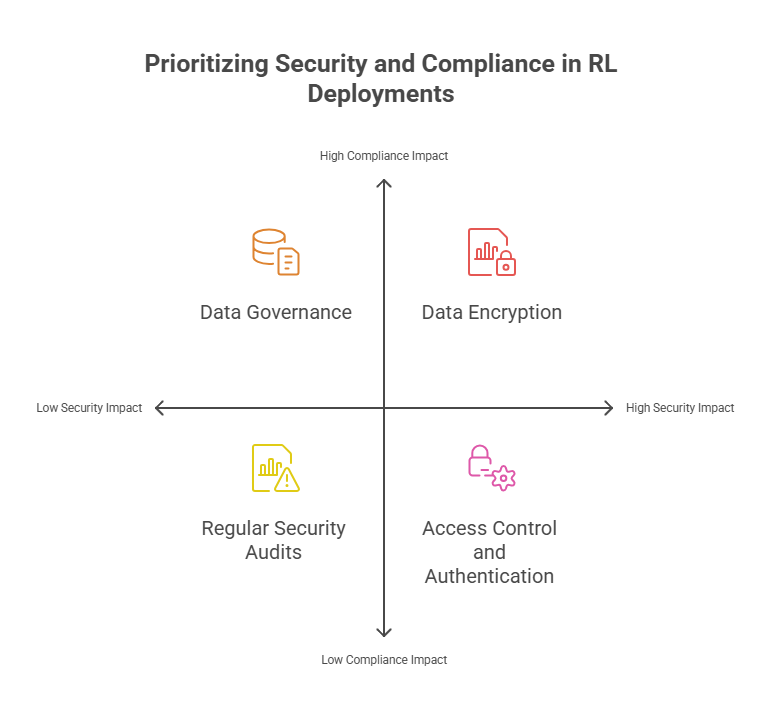
Scaling RL Training: Distributed Computing and Cloud Solutions
Scaling reinforcement learning (RL) training is essential for tackling complex environments, large datasets, and advanced agent architectures. As RL models and environments grow in complexity, single-machine training quickly becomes a bottleneck. Distributed computing and cloud solutions offer the scalability, flexibility, and efficiency needed to accelerate RL research and production deployments. In this article, we explore best practices, popular frameworks, and practical strategies for scaling RL training using distributed and cloud-based resources.
Why Scaling Matters in RL
RL training is often computationally intensive, requiring millions of environment interactions and large-scale simulations. Scaling enables:
Faster Experimentation: Parallelizing training and evaluation shortens development cycles.
Handling Complex Environments: High-fidelity simulators and large state spaces demand more compute power.
Hyperparameter Optimization: Running multiple experiments in parallel to find optimal configurations.
Production Readiness: Supporting real-time or near-real-time learning in dynamic environments.
Best Practices for Distributed RL Training
Leverage Parallel Environments: Use frameworks that support running multiple environment instances in parallel, such as OpenAI Gym’s VectorEnv or Ray RLlib.
Distributed Policy Optimization: Implement distributed versions of RL algorithms (e.g., A3C, IMPALA, PPO) to scale policy updates across multiple workers.
Efficient Resource Management: Use orchestration tools (Kubernetes, Docker Swarm) to allocate and monitor compute resources.
Cloud-Native Training Pipelines: Deploy RL workloads on cloud platforms (AWS, Azure, GCP) to access scalable GPU/TPU clusters and managed services.
Automated Experiment Tracking: Integrate experiment tracking tools (MLflow, Weights & Biases) to manage large-scale runs and results.
Popular Frameworks and Tools
Ray RLlib: A scalable RL library supporting distributed training, hyperparameter tuning, and integration with cloud platforms.
Stable Baselines3: Supports parallel environments and can be extended for distributed training.
Horovod: Enables distributed deep learning, including RL, across multiple GPUs and nodes.
KubeFlow Pipelines: Orchestrates complex RL workflows on Kubernetes clusters.
Example: Distributed RL Training with Ray RLlib
Here’s a simple example of scaling RL training using Ray RLlib, which can run on local clusters or in the cloud:
python
import ray
from ray import tune
from ray.rllib.agents.ppo import PPOTrainer
ray.init() # For cloud, configure with address and resources
tune.run(
"PPO",
config={
"env": "CartPole-v1",
"num_workers": 4, # Number of parallel environment workers
"framework": "torch",
},
stop={"episode_reward_mean": 200},
)
Created/Modified files during execution:
print("ray_results/")This setup allows you to scale out training across multiple CPUs or GPUs, dramatically reducing training time.
Cloud Solutions for RL Training
Major cloud providers offer managed services and infrastructure for scalable RL training:
AWS SageMaker RL: Managed RL training with support for distributed algorithms and custom environments.
Google Cloud AI Platform: Scalable training jobs, hyperparameter tuning, and integration with RL frameworks.
Azure Machine Learning: Distributed training, experiment tracking, and deployment for RL agents.
Challenges and Tips
Cost Management: Monitor resource usage and optimize workloads to avoid unnecessary cloud expenses.
Data Transfer: Minimize data movement between nodes and storage to reduce latency and costs.
Fault Tolerance: Use checkpointing and automated recovery to handle interruptions in distributed training.
Summary
Scaling RL training with distributed computing and cloud solutions unlocks new possibilities for research and enterprise applications. By leveraging parallelism, cloud infrastructure, and modern orchestration tools, you can accelerate RL development, handle complex environments, and deploy robust agents at scale.
